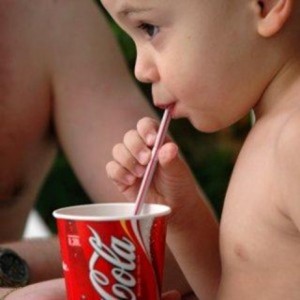 Are our children being trained into addiction?
Are our children being trained into addiction?
Children can’t avoid caffeine, and they soon grow to love it in their crackers, in cookies, candy, gum, jelly beans, and soft drinks. Since caffeine is neither a preservative nor a purifier, any claims that caffeine is being added to our children’s food for some beneficial or simply benign purpose is spurious. So what is caffeine doing in our children’s food?
The bottom line is that food and drink producers add this tart white powder to their products because it has a zing and a kick; it adds to the pleasurable experience of eating heavy concentrations of sugar and salt, so kids are attracted and their mouths crave the products. Is caffeine being added to many children’s food solely to sell more products?
Quiz: Is Your Body TOXIC? Take the Test...
(get your free personalized report)
Is Caffeine Really Addictive?
Caffeine currently fulfills the DSM-IV diagnostic classification as a psychoactive addictive agent, although many pediatricians would take the classification farther into the physical realm.
For now, though, it is only classed as psychologically “addictive”. Yet make no mistake, however: if you drink thirty or forty coffees or sodas in a given day (3,000 or 4,000 mgs), you can die, but before that you will likely experience a range of symptoms most adults know well—the racing heart, sweating, tinnitus, headache, jitters, sleeplessness, and erratic, jumbled thinking.
The problem with overdosing on caffeine, even if one does not die, is that the victim thinks the best solution to relieve those symptoms is to consume more caffeine. Unlike other pernicious addictions, to overdose on caffeine is to experience precisely the same symptoms as one does during withdrawal from the substance – mortality aside.
Keeping in mind that an average cup of Maxwell House coffee contains 100 mg, however figures for Isagenix Coffee are not currently available. Here is a chart of caffeine amounts in common products. Most are for “adult” products. Of course, it takes three to four thousand mgs of caffeine to OD and die, but who among us, having had a single cup, has not slowly added more cups to our daily dose?
Caffeine researcher Roland Griffiths, PhD, Johns Hopkins University, claims that caffeine is the most widely used mood-altering drug in the world – its usage far exceeding that of alcohol and nicotine.
Quiz: Is Your Body TOXIC? Take the Test...
(personalized report)
“Research has shown that the dose of caffeine delivered in a single can of soft drink is sufficient to produce mood and behavioral effects,” he says. “Children who haphazardly consume caffeine are at risk of going through alternating cycles of withdrawal and stimulation.”
Given that kids drink 20 times more soda than they did ten years ago, caffeine consumption and addiction becomes a more urgent consideration. Thirty percent of all caffeine consumers, including children and adolescents, fulfill the DSM-IV diagnostic criteria for a drug dependence syndrome, which includes tolerance, withdrawal, the desire and the inability to quit. Studies have confirmed withdrawal and the dependence syndrome in children and adolescents.
Most pediatricians are concerned that we are setting children up for a lifetime of unnecessary mood swings via withdrawal and stimulation because of addiction to caffeine, and physicians are concerned that by constant exposure to caffeine, our hearts and central nervous systems are being ‘exercised’ in ways that are unnatural and can have serious medical consequences over time.
Substitutes for caffeine and caffeinated products
You might do well to explore carob and carob powder as a substitute for any and all cocoa-based products. Carob is similar to coca and grown in the same regions as coca plants, but it contains absolutely no caffeine – which affects the central nervous system – or theobromine – which affects the cardiovascular and pulmonary systems.
For what it’s worth, it is theobromine in chocolate which is toxic to dogs; so many approved “chocolate” dog treats are made from carob.
Carob is still relegated to the back shelves of health food stores, even though there was a concerted effort in the late ‘60s and early ‘70s to pit carob head-to-head against the chocolate giants. Nestle won, of course, but it may be time for another go at the war because carob has a wonderfully rich creamy taste, which many prefer over coca-based products.
Since carob has little value to add to energy drinks or soft drinks – the tartness of caffeine is what gives soft drinks their punch, their “zest” – all that can be done to prevent children taking in the 30 -60 mgs of caffeine in an average size soft drink or “energy” drink is to turn them toward juices and to other non-cocoa-based soft drinks.
But … Is Caffeine Addiction Bad?
While there are moderately helpful qualities of caffeine as a stimulant, including some evidence that caffeine actually counteracts some symptoms of ADHD, common sense forces us to one basic conclusion: anything which controls or affects our mood or behavior, and which is addictive and which causes discomfort when one attempts to withdraw from its usage, is best avoided.
Certainly there are worse addictions that result in more serious medical problems, but caffeine is a very addictive drug, and although the unwanted effects of the addiction are fairly benign compared to other drugs and other addictions, parents are well-advised to be attentive to the amount of caffeine their children are consuming each day.
Addictions of any kind are unhealthy.
Resources:
Caffeine as performance enhancer (positive)
http://www.jaacap.com/article/S0890-8567%2809%2964184-8/abstract
Caffeine (pos/neg)
http://psycnet.apa.org/journals/pha/6/1/87/
Children in withdrawal from caffeine
http://www.jaacap.com/article/S0890-8567%2809%2966602-8/abstract
Childhood sleep disorders
http://onlinelibrary.wiley.com/doi/10.1111/j.1469-8749.1999.tb00657.x/abstract
Adolescent addiction
http://www.sciencedirect.com/science/article/pii/S0376871601001818
Energy Drinks
http://pediatrics.aappublications.org/content/127/3/511.short
